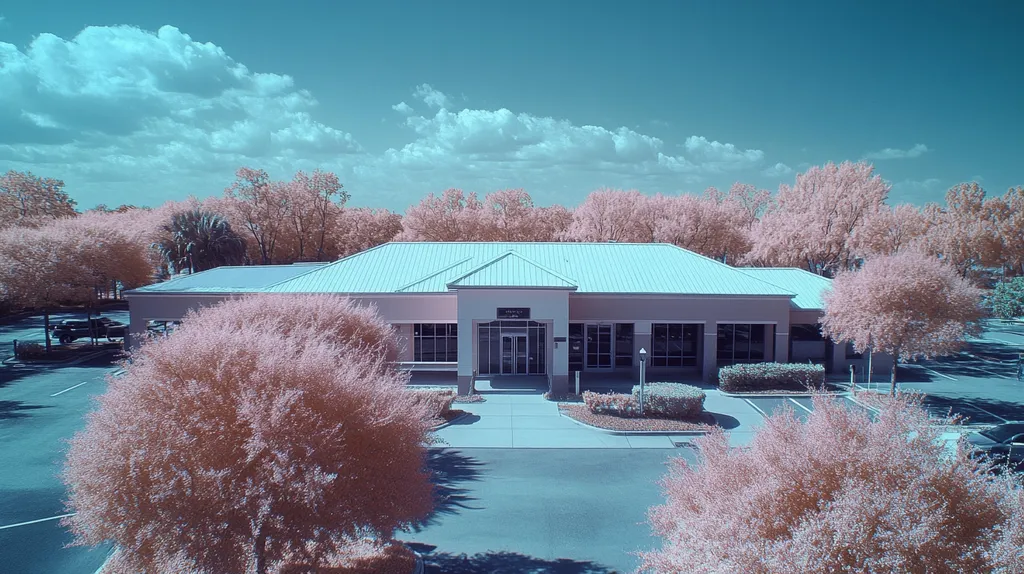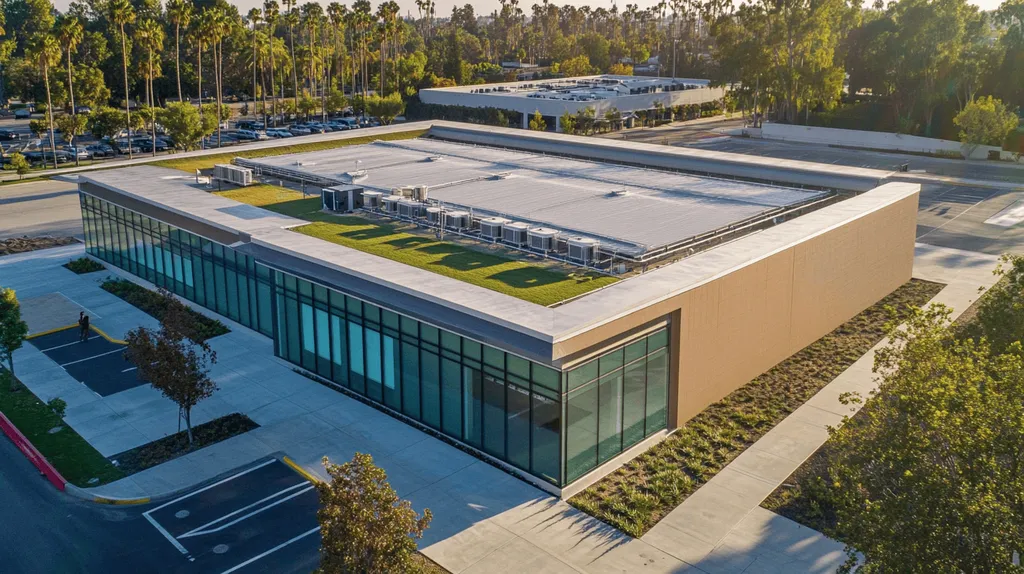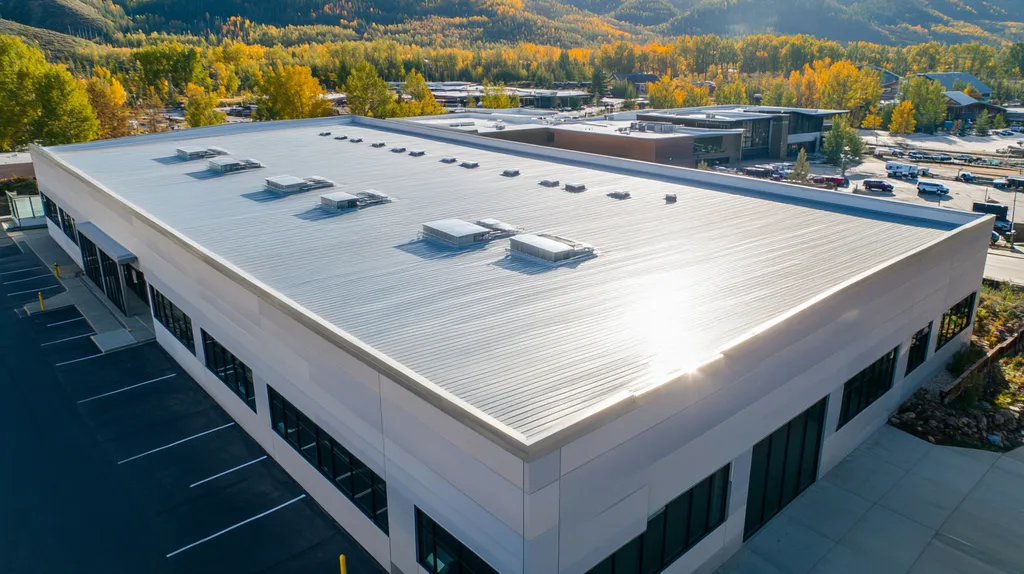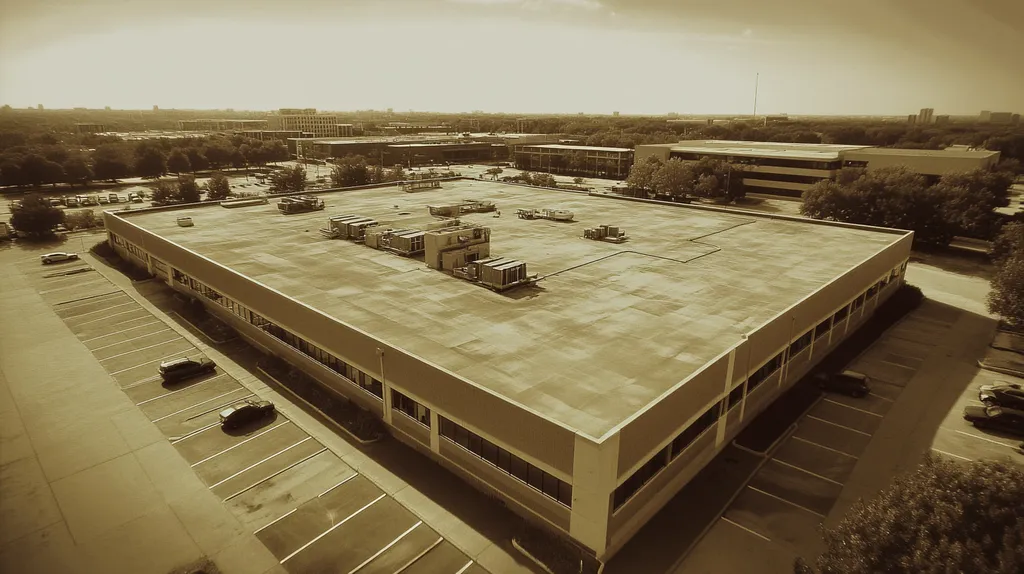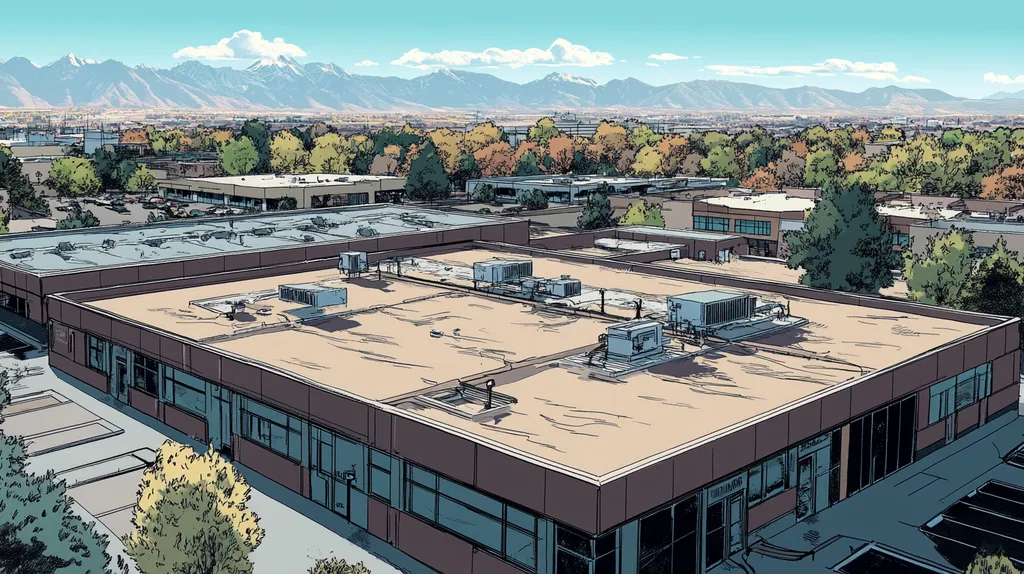When a commercial roof starts leaking at 2 AM during a thunderstorm, every second counts. Studies show that delayed responses to roof emergencies can multiply repair costs by up to 10 times, while causing devastating interior damage that disrupts business operations.
Understanding emergency fixes for commercial roofs isn’t just helpful—it’s essential for protecting your investment and maintaining business continuity. This comprehensive guide breaks down the crucial elements of emergency repairs, from immediate response strategies to long-term solutions.
Whether you’re dealing with sudden leaks, storm damage, or other roofing crises, you’ll discover practical steps to minimize damage and make informed decisions when time is of the essence.
SECTION 1: THE BASICS EXPLAINED
When unexpected issues strike a commercial roof, the consequences can be severe—think costly damage, safety hazards, and business disruptions. It’s alarming to know that around 60% of all roofing failures stem from inadequate maintenance, according to the Roofing Contractors Association. Being familiar with emergency fixes is not just useful; it’s a vital step in safeguarding your building from serious complications. In this section, we’ll break down what these emergency fixes are, why they hold such importance, and how to effectively implement them.
What It Is (In Plain Language)
Emergency fixes for commercial roofs are immediate repairs triggered by sudden problems—think leaks from storm damage, broken flashing, or punctures in the roofing membrane. These urgent solutions are intended to shield the building and its contents until a more permanent fix can be put in place.
Taking quick action is essential because ignoring these pesky issues can snowball into bigger, pricier problems. Common emergency fixes include peel-and-stick patches, temporary covers, or sealing compounds. These straightforward yet effective methods can stop further water intrusion and prevent significant structural damage.
By understanding these immediate repair options, building managers can make wise decisions when roofing emergencies arise. Proactive measures can lead to substantial savings in both time and money in the long run.
Why It Matters (To Your Building)
The soundness of a commercial roof is crucial for the safety and functionality of your entire building. Delaying repairs can drastically heighten risks such as water damage, mold growth, and threats to structural integrity.
Moreover, quick emergency fixes play a pivotal role in minimizing downtime for businesses. A substantial leak could halt operations, leading to lost revenue and diminished productivity.
On top of that, a well-maintained roof can enhance the lifespan of your entire roofing system. By carrying out regular emergency repairs when necessary, you can improve performance and avoid hefty replacement costs down the line.
It’s imperative for property owners and facility managers to understand that addressing these urgent repairs is an investment in the future of their buildings. Ignoring these problems can escalate into extensive repairs, ultimately weighing heavily on the bottom line.
How It Works
Implementing emergency roof fixes typically involves several key steps. First, a thorough damage assessment is crucial to pinpoint the scale of the issue. This assessment may involve visual inspections or even infrared evaluations to discover hidden leaks.
After identifying the problem, qualified professionals can apply the right solutions. Quick patches, for instance, can protect vulnerable areas, allowing for immediate defense without extensive repairs.
Education stands out as a vital component for relevant staff and maintenance teams. Equipping them to recognize early signs of roofing problems allows for swift action, which can avert major damage.
Finally, it’s essential to document all emergency repairs for future reference. Keeping track of these repairs can streamline long-term maintenance planning and facilitate informed decision-making regarding full restorations later on.
SECTION 2: PRACTICAL APPLICATIONS
When roof troubles strike unexpectedly, they can unleash a whirlwind of chaos, from costly repairs to debilitating business interruptions. In fact, a single day of downtime may cost a commercial operation thousands, making emergency fixes not just smart but essential. This section dives into common emergency scenarios, the urgency of quick solutions, and how roof issues can affect other building systems.
Common Uses & Examples
Emergency fixes serve as crucial lifelines during unpredictable roof troubles, like storm damage or sudden leaks. For instance, a puncture from debris can quickly lead to unwanted water intrusion. By utilizing a waterproof tarp or a roofing membrane as a temporary cover, property managers can shield their buildings from extensive damage until a permanent fix is arranged.
Another common scenario involves unexpected accidents at a worksite, which can also compromise the roofing system. In these cases, foam sealants or roof patches are invaluable quick repair options. These solutions create effective barriers that prevent further damage and afford time for professional repairs.
Emergency tarping is particularly useful on flat roofs suffering from drainage issues that result in water pooling. Implementing these temporary solutions helps maintain operations while addressing the core problems that led to the leaks.
In every situation, rapid response is crucial. The longer a roofing issue goes unattended, the more severe—and costly—the upcoming repairs will be.
When You Need It Most
The best time to spring into action with emergency fixes is right after a major weather event or the moment a leak is discovered. For example, following a heavy rainstorm or hail, a thorough roof assessment is essential. Quickly identifying damage allows for prompt application of temporary fixes, helping to stave off larger problems
For buildings in regions prone to harsh weather, stocking emergency roofing materials can be a game changer. This proactive stance ensures precious time isn’t wasted during emergency situations when every second counts.
Additionally, integrating emergency responses into an emergency preparedness plan adds another layer of protection. Training designated personnel in tackling emergency fixes expedites response time significantly, which can lead to substantial financial savings.
By taking swift action, property owners can dramatically lower the extent of long-term damage and ultimately protect their investments.
Interactions With Other Systems
Understanding how roofing systems interrelate with other building components is critical during an emergency. A compromised roof can adversely impact HVAC systems, potentially leading to costly heating and cooling repairs. Water entry may damage insulation and even endanger electrical systems, creating severe safety risks.
It’s also important for emergency fixes to take the integrity of existing roofing materials into account. Using incompatible substances can worsen issues rather than resolve them, ultimately harming energy efficiency.
Collaboration with maintenance teams enhances the likelihood that emergency fixes will align with overall building management protocols. Open communication helps prevent oversights, such as failing to check HVAC systems after a roof issue.
Finally, a well-executed emergency roofing solution bolsters the overall resilience of the building structure. By ensuring all systems function together seamlessly, property owners can better prepare for future emergencies.
SECTION 3: KEY TERMINOLOGY DECODED
Grasping essential roofing terminology is critical when responding to emergencies. Misunderstanding common terms can lead to ineffective repairs, and costly mistakes may follow. For example, mixing up «ponding» and «pooling» water can escalate a minor leak into a serious structural nightmare. This section will clarify the most important terms, untangle industry jargon, and simplify measurement units to empower property owners and facility managers in critical situations.
Essential Terms Explained
In roofing vocabulary, “flashing” is a key term referring to the materials that redirect water away from vulnerable areas like chimneys and joints. Properly installed flashing is non-negotiable; subpar flashing often leads to leaks, especially during storms. The term “drainage” comes into play as well, denoting the system designed to channel water off the roof. If drainage fails, standing water can spell disaster for your roof’s integrity.
Another important term is “substrate,” which refers to the underlying layer that supports the roofing material. A deteriorating substrate can undermine even the sturdiest new roof. By familiarizing with these terms, property owners can make savvy choices when addressing roofing challenges.
Quickly recognizing these terms during a rainstorm crisis can bring clarity. Is the ponding due to clogged drains, or is it a deeper structural issue? Clear definitions empower property managers to swiftly tackle the right problems before they escalate.
Industry Jargon Translated
Industry jargon can muddle communication among all parties involved. For example, “roof pitch” describes the slope or angle of the roof. A steeper pitch can improve runoff but complicates maintenance and inspections. Knowing this term helps property owners better understand their roof’s maintenance requirements and potential risks.
“Membrane” is another crucial term, referring to the waterproof barrier used primarily for flat roofs. Different types, such as EPDM and TPO, come with unique properties and installation processes. Being knowledgeable about these allows property managers to choose effective materials when quick repairs are needed.
Don’t forget “thermal insulation,” a layer that maintains comfortable indoor temperatures and enhances energy efficiency. In urgent situations, understanding how insulation interacts with roofing can aid in making prompt decisions to avoid further damage.
Measurement & Units Simplified
Accurate measurement is essential for executing roofing repairs effectively. The term “square” defines an area of 100 square feet—a must-know for calculating the materials needed for emergency fixes.
Additionally, mastering how to measure “pitch” is vital for roof inspections. Often expressed as a ratio like 4:12, it indicates the height gain over horizontal distance. This info is critical when examining drainage needs and evaluating installation techniques.
An equally important unit is “gauge,” commonly referring to the thickness of materials like metal roofing. Thicker gauges typically assure greater durability, but they can also add weight, which affects structural considerations during emergency repairs.
SECTION 4: DECISION FACTORS
When unexpected roof issues occur, the instinct to rush toward a hasty fix is strong. However, this approach can lead to unexpected financial burdens and affect the roofing system’s long-term performance. Understanding key factors is essential as commercial property owners and facility managers navigate emergency repairs. This section dives into cost considerations, performance trade-offs, and lifespan factors that shape effective roofing solutions.
Cost Considerations
Cost is often front and center during emergency roof repairs. Initially, prices may seem manageable, but hidden costs can crop up if the solution isn’t fully assessed. For instance, opting for a cheaper temporary patch might lead to extensive repairs down the line if underlying issues are ignored.
This financial escalation can strain the property budget significantly. While quality materials and skilled labor might carry higher upfront costs, they can save money by reducing the frequency of future repairs. Moreover, failing to set aside budget for complexities can lead to financial turmoil.
It’s also vital to factor in long-term operational efficiency. Poor repairs might spike energy bills if the roof fails to provide proper insulation or ventilation. Striking a balance between short-term savings and future expenses is essential for informed decision-making.
Ultimately, grasping the nuances of cost dynamics empowers property owners to protect their investments effectively.
Performance Trade-offs
Emergency fixes often come with performance trade-offs that shouldn’t be overlooked. Quick solutions may not deliver the same efficacy as more comprehensive repairs. For example, a hastily applied sealant might prevent immediate leaks but fail to tackle structural vulnerabilities lurking beneath.
Trade-offs can extend to the materials selected, too. Temporary options often lack the durability to withstand environmental stressors. A low-quality patch, for instance, could degrade quickly, leading to more repairs shortly after installation.
Additionally, performance trade-offs don’t only relate to the roofing material—they can disrupt overall building operations. A poor fix can result in continued leaks, damaging interior fixtures or equipment, leading to operational setbacks.
Prioritizing quality over speed ensures your roof can withstand the elements while minimizing the risk of recurring issues in the future.
Lifespan & Durability Factors
The lifespan and durability of roofing solutions are crucial for long-term planning. Emergency fixes generally address immediate concerns but may overlook the overall health of the roofing system. This oversight can lead to premature replacements or repairs.
Utilizing high-quality materials is essential for ensuring durability. For instance, a robust roof covering can significantly extend a roof’s lifespan, helping to decrease the frequency of future repairs. Understanding the anticipated lifespan of various materials helps craft smarter procurement strategies.
Durability must also be evaluated considering the surrounding environment. Climate, weather patterns, and nearby terrain can all significantly influence roof longevity. Tailoring solutions to these specific site conditions enhances durability and lessens overall maintenance needs.
In conclusion, balancing lifespan and durability against immediate emergency needs is critical for safeguarding investments and achieving long-term success.
SECTION 5: COMMON CHALLENGES
In the bustling world of commercial roofing, unplanned issues can escalate into significant disasters if not managed swiftly. Did you know that around 60% of businesses face roof-related emergencies that disrupt daily operations and can lead to hefty repair costs? It’s critical for property owners to recognize frequent problems, be aware of warning signs, and implement proactive strategies to safeguard their roofs. This section uncovers the most common challenges while spotlighting effective ways to mitigate risks.
Frequent Problems & Solutions
Water infiltration tops the list of challenges for commercial roofs and often springs from compromised seams or pesky punctures. Regular inspections can spot these issues before they spiral out of control. A quick fix like roofing sealant or tape can be an effective stopgap while planning for more comprehensive repairs.
Another common woe is membrane blisters, those stubborn bubbles that form when moisture gets trapped beneath the surface. Left unchecked, these blisters can wreak havoc. The best approach involves carefully removing the blister and sealing the area to prevent it from returning.
Debris accumulation is another sneaky culprit that can lead to undesirable water pooling, speeding up wear and tear. A simple routine of clearing gutters and roof surfaces goes a long way in mitigating this risk. In some cases, a well-designed drainage system may offer a more lasting solution.
Tackling these recurring problems with timely action not only avoids catastrophic outcomes but also keeps operations running smoothly and repair costs manageable.
Warning Signs To Watch For
Spotting red flags early can be a game-changer for avoiding anxious roofing emergencies. Water stains on ceiling tiles or walls are often the first telltale signs of leaks, indicating that immediate inspections are necessary to pinpoint the source of water intrusion.
Curling or cracked roofing materials also act as warning signals that a roof might be nearing its expiration date. Such signs suggest that proactive maintenance or replacement is likely on the horizon.
Keep an eye on rising energy bills, too. They may hint that a roof isn’t performing as it should. Issues like poor insulation or hidden leaks can cause heating and cooling costs to skyrocket, emphasizing the need for routine checks.
By vigilantly monitoring these indicators, property owners can act fast, preserving the integrity of their buildings and protecting their wallets.
Preventative Approaches
Preventative maintenance serves as the backbone of effective roof management. It’s wise to set up a regular inspection schedule—aim for twice a year—to catch potential problems before they escalate into full-blown emergencies. Each inspection should involve checking for wear, assessing sealants, and ensuring that drainage systems are functioning properly.
Investing in high-quality roofing materials may seem like a larger upfront investment, but their durability pays dividends over time. These materials can significantly extend a roof’s lifespan while slashing maintenance requirements.
A proactive debris removal plan is also essential. Regular cleanings prevent deterioration caused by trapped debris and help prolong the life of the roof, minimizing the chances of emergency repairs.
In summary, adopting a comprehensive preventative maintenance strategy not only secures the roof but also reduces the likelihood of unexpected emergencies that could disrupt business operations down the road.
SECTION 6: NEXT STEPS & RESOURCES
When it comes to emergency roof issues, every minute counts. A small problem, like a seemingly harmless leak, can snowball into extensive damage and hefty repair bills—imagine the hassle of mold growth disrupting your facility’s operations! To navigate these urgent situations, property owners and facility managers need the right questions and resources at their fingertips. This section serves as your trusty guide, highlighting pivotal questions to ask roofing providers, industry standards to follow, and additional resources for enhancing your roofing know-how.
Questions To Ask Providers
Choosing the right roofing contractor for emergency repairs is essential for minimizing damage. Start by asking about their experience with similar emergency situations. A contractor who understands your specific roofing material can respond more effectively to unexpected challenges.
Next, inquire about their response time. During an emergency, every moment matters—knowing a contractor can act quickly can save your facility from substantial damage.
Don’t hesitate to ask about warranties and guarantees, either. It’s important to know what protection applies to emergency repairs. Request written documentation detailing their responsibilities and your rights, so you’re in the know.
Finally, confirm that the contractor adheres to safety regulations and industry standards. This not only safeguards their workers but also ensures that repairs are executed smoothly and effectively.
Industry Standards & Guidelines
Familiarizing yourself with industry standards is pivotal for navigating roofing repairs wisely. Organizations like the National Roofing Contractors Association (NRCA) provide crucial guidelines for effective roofing practices, particularly during emergencies.
These standards stress the importance of qualified personnel. By utilizing skilled labor, errors during repairs are minimized, thereby maintaining the integrity of roofing systems. Proper training ensures that contractors tackle issues without compromising safety.
Compliance with local building codes is equally important. These regulations can vary by area, and adhering to them prevents legal issues and further damage. Ensure that your contractor is licensed and knowledgeable about your local codes.
Lastly, don’t forget about the resources from the American National Standards Institute (ANSI). Their guidelines offer insight into practices that enhance the quality and reliability of roof repairs, empowering you to make smarter long-term maintenance choices.
Further Learning Simplified
Ongoing education is a must for property owners and facility managers facing roofing emergencies. Taking advantage of online training modules can build a solid foundation in roofing systems and maintenance strategies.
Consider joining webinars led by industry experts. These sessions unpack recent trends, common roofing issues, and effective solutions that can empower managers to act wisely during emergencies.
Subscribing to industry publications is another great step. These resources keep you updated on best practices and innovative roofing technologies that contribute to enhanced roof longevity.
Lastly, networking with fellow property owners can offer invaluable insights. Sharing experiences and solutions fosters a community of informed professionals—ready to tackle emergencies and maintain resilient roofs!
The Bottom Line
With commercial roof repairs costing businesses an average of $4-7 per square foot when promptly addressed—but skyrocketing to $30-50 per square foot when delayed—the stakes couldn’t be higher.
Emergency fixes serve as a critical defense against catastrophic damage, protecting not just the building envelope but the entire business operation.
By understanding common issues, maintaining a response plan, and partnering with qualified contractors, property owners can significantly reduce both repair costs and business disruption.
Remember: the difference between a minor repair and major catastrophe often comes down to response time and preparation.
Moving forward, prioritize preventative maintenance while keeping emergency protocols and contacts readily available—because the next roofing crisis isn’t a matter of if, but when.
FREQUENTLY ASKED QUESTIONS
Q. What are emergency fixes for a commercial roof?
A. Emergency fixes refer to immediate repairs needed for sudden roof issues. They aim to protect the building until permanent solutions can be arranged. Examples include waterproof patches or temporary covers that stop leaks and prevent major damage.
Q. When are emergency fixes necessary for an industrial roof?
A. Emergency fixes are vital right after severe weather or when leaks are discovered. Addressing damage immediately helps prevent costly repairs and operational disruptions. Quick assessment and temporary coverage are key to maintaining functionality during emergencies.
Q. What terminology should I know for commercial roof emergencies?
A. Key terms include “flashing,” which directs water away from vulnerable areas, and “drainage,” which channels water off the roof. Understanding these terms helps in identifying and addressing issues quickly, ensuring effective communication and repairs.
Q. What factors influence decisions during industrial roof emergencies?
A. Cost considerations, performance trade-offs, and material lifespan are crucial. Cheaper fixes may seem appealing but can lead to larger expenses later. Balancing immediate and long-term needs is essential for effective decision-making during emergencies.
Q. What common challenges do commercial roofs face?
A. Common issues include water infiltration from seams or punctures, membrane blisters, and debris build-up. Regular inspections help identify these challenges early on, allowing for effective solutions before they escalate into emergencies.
Q. What questions should I ask roofing contractors during emergencies?
A. Ask about their experience with emergency situations, response times, and warranties for repairs. It’s also crucial to confirm their adherence to safety regulations and industry standards. This ensures you choose a qualified contractor for effective repairs.
Q. How can I prepare for potential commercial roof emergencies?
A. Create an emergency preparedness plan that includes training designated staff on quick fixes and establishing routine inspections. Stocking necessary materials and staying informed about industry practices can better prepare your team for any situation.

